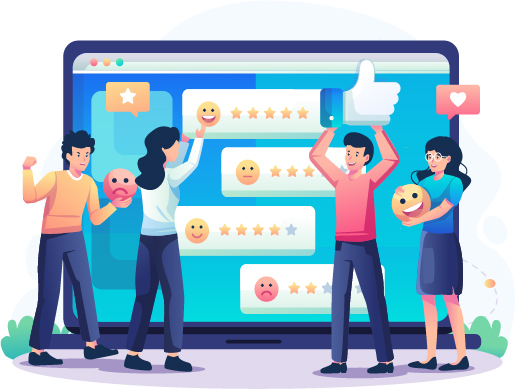WHAT IS WEBSITE DESIGN?
Website development involves the planning, implementation, and creation of a website in its entirety, including all of the pages, written content, any videos or images, and every other aspect that makes up a site. Our professional team of website developers at HUGO Bea know their way around WordPress, as well as understanding coding languages and how to implement different factors into a site.
WHY WOULD I NEED A WEBSITE DESIGNER?
A lot of new businesses, and even some older ones, do not have websites that fully tap into the importance and prowess of the digital world. In the modern day, more customers use online shopping than they do physical shopping. With the digital world becoming more and more prevalent, it is important for businesses to have functioning websites that not only contain information about their services, but also give them a digital presence along with any social media they may have.

THE BASICS OF WEB DESIGN
Web design is a multifaceted discipline that combines various elements to create functional and aesthetically pleasing websites. Understanding the elements of web design is crucial for creating sites that not only look good but also provide an excellent user experience. Key elements include layout, colour, typography, imagery, and interactivity. The layout refers to how content is structured and categorised on the page, playing a critical role in usability and functionality. Colour is used to evoke emotions, convey messages, and create a visual identity for the brand. Typography involves choosing typefaces and arranging text in a way that is both readable and visually engaging.
The interplay of layout, colour, and typography is essential in creating a cohesive and harmonious design. A well-thought-out layout ensures that information is presented in an organised and accessible manner. Colour schemes should complement the brand and the content, while typography should enhance readability and contribute to the overall aesthetic of the site. The combination of these elements should reflect the brand’s personality and resonate with its target audience.
USER EXPERIENCE (UX) AND USER INTERFACE (UI) DESIGN
UX and UI design are integral parts of web design, focusing on the overall feel and look of the website, respectively. UX design is about creating a website that is easy and pleasant to use. It involves understanding the users’ needs and preferences to create an intuitive and efficient experience. UX designers consider how the website functions and how users interact with it, aiming to make the user’s journey as smooth and satisfying as possible.
UI design, on the other hand, focuses on the visual and interactive elements of the website. It involves designing a website’s interface, incorporating elements like buttons, icons, spacing, and responsive design. The goal of UI design is to create a website that is not only visually appealing but also intuitive to navigate. UI designers work to ensure that the website is accessible and easy to use, with a focus on the look and layout of the elements on the page.
CASE STUDIES: OUR CLIENTS
Browse some of our web-design projects and see the many ways that we can design a website to work for you.
RESPONSIVE AND ADAPTIVE WEB DESIGN
The concepts of responsive and adaptive design are crucial for creating websites that provide an optimal viewing experience across a variety of devices. As the use of mobile devices continues to surge, the importance of mobile-first design has become more pronounced. This approach prioritises the mobile user experience in the design process, ensuring that websites are fully functional and visually appealing on smaller screens before scaling up to larger devices like desktops.
Responsive Design: This approach involves creating a single website that dynamically adjusts its layout, content, and functionalities to fit the screen size of the device it’s being viewed on. Responsive design uses fluid grids, flexible images, and CSS media queries to adapt to the user’s device, providing a seamless experience whether they’re on a phone, tablet, or desktop.
Adaptive Design: In contrast, adaptive design uses distinct layouts for multiple screen sizes. Instead of a single fluid layout, adaptive design detects the device being used and delivers a pre-set layout specifically designed for that screen size. This means a website might have different layouts for mobile, tablet, and desktop, each optimised for the best user experience on that particular device.
MOBILE-FIRST DESIGN
Mobile-first design is essential in today’s digital landscape where a significant portion of web traffic comes from mobile devices. This design philosophy helps in improving the user experience for mobile users, who often encounter challenges with navigation, readability, and load times on sites not optimised for mobile. By adopting a mobile-first approach, designers and developers can ensure that the website’s most important features are accessible and user-friendly on mobile devices, which can lead to increased engagement, lower bounce rates, and better search engine rankings.
IS THERE A WEBSITE DESIGNER NEAR ME?
Finding a local website designer could prove to be a challenge, but we at HUGO Bea are a top choice for web development and all related services. If you are pondering about the closest website designer near me, look no further than HUGOBea, offering everything from site audits to fully-fledged, search engine optimised sites for your company and brand.
HOW DID HUGO BEA HELP YOU?
“Before meeting HUGO Bea, I used to rely on social media and word of mouth to get new customers on our books. HUGO Bea worked with me to design a website which was needed to advertise my new commercial service – Biohazard cleaning. A large commercial organisation contacted me as a result of the website.”

“HUGO Bea built us a website so that we can attract new members, advertise upcoming shows and sell more tickets to shows and events. We are a 103 year old society and this is the first time we have had a website so it is a big change for us as an organisation. It is a great central point for people to come to when looking for information about what we do.”
THE PROCESS OF EFFECTIVE WEBSITE DESIGN
The aforementioned factors are all incredibly important, but are just a few of the things to remember when designing a website. Effective web design is not just about aesthetics; it’s about creating a site that is intuitive, user-friendly, and aligned with the brand’s objectives. Clarity and simplicity are at the heart of good web design. This means designing pages that are not cluttered, using clear and concise language, and ensuring that the purpose of each element on the page is obvious to the user. The goal is to make it easy for visitors to understand what the site is about and to find the information they need without feeling overwhelmed.
Navigation and accessibility are also key principles of effective web design. A well-designed navigation system acts as a roadmap to guide visitors through the site, making it easy for them to explore and find what they are looking for. Accessibility is about ensuring that the website is usable by people of all abilities and disabilities, which includes designing for screen readers, ensuring proper colour contrast, and providing alternative text for images.
Consistency and branding are crucial for creating a cohesive web experience. This involves using consistent fonts, colours, and layout styles that align with the brand’s identity. Consistent branding helps in building trust and recognition with users, making the website an integral part of the brand’s overall digital presence. The integration of on-page SEO best practices in web design is essential for ensuring that websites not only look good but are also discoverable by search engines. This includes optimising website elements like titles, headings, and meta descriptions, as well as ensuring that the site’s structure and navigation are search engine friendly. The use of alt tags for images, proper URL structures, and the inclusion of keywords in the content and tags are all important for SEO.
Designing a website is a comprehensive process that transforms a concept into a fully functional and visually appealing online presence. This journey from concept to launch involves several key steps, each crucial to the success of the final product.
The initial phase of the web design process is the conceptualization stage, where the primary focus is on understanding the client’s vision, objectives, and target audience. This stage often involves extensive research, including analysing competitors and identifying the unique selling points of the client’s business or service. Following this, a wireframe or a basic layout of the website is created, which serves as a blueprint for the site’s structure and functionality. Once the wireframe is approved, the design phase begins. This is where the visual elements of the website, such as colour schemes, typography, and imagery, are developed. Designers work to create an aesthetic that aligns with the brand’s identity and appeals to the target audience. The design phase is iterative, often involving feedback and revisions to ensure the final design meets the client’s expectations.
After the design is finalised, the development phase commences. Developers take the design and turn it into a functioning website. This involves writing code, implementing the back-end functionality, and ensuring the site is responsive and optimised for different devices and screen sizes. During this phase, it’s crucial for designers and developers to collaborate closely to ensure the integrity of the design is maintained and the website functions smoothly. The final stages of the web design process include testing and launch. The website undergoes rigorous testing to identify and fix any issues, such as broken links, compatibility problems, and performance issues. Once testing is complete and the site is optimised for search engines, it is ready for launch.
Collaboration between designers, developers, and clients is integral throughout the web design process. Effective communication and teamwork ensure that the website not only looks visually stunning but also performs well, meets the client’s needs, and provides an excellent user experience. After launch, the website may still require ongoing maintenance and updates, which are essential for keeping the site relevant and engaging.






